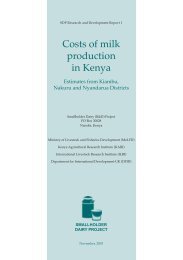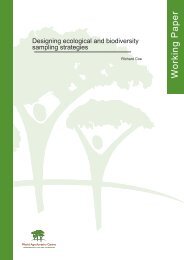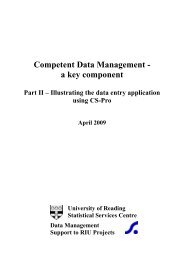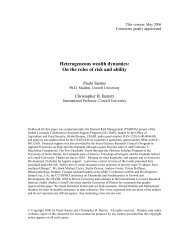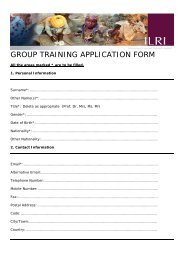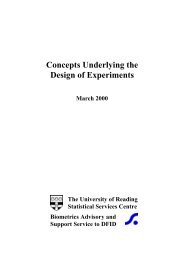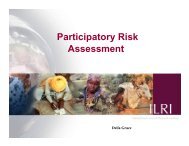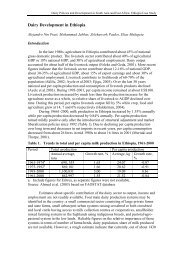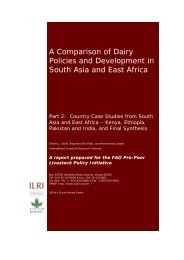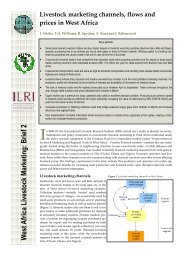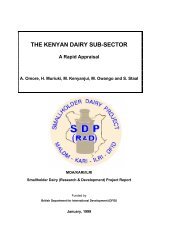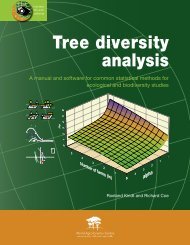Malaysia is characterised by a humid tropical climate with heavy ra<strong>in</strong>fall (2540 mm and above). Averagedaily temperatures are 21–32°C with humidity averag<strong>in</strong>g about 85% (Mukherjee 1995). Three dist<strong>in</strong>ct soilgroups are recognised compris<strong>in</strong>g the sedentary soils <strong>of</strong> the hills and mounta<strong>in</strong>s, and the alluvial and peatysoils <strong>of</strong> the lowlands and uplands. The sedentary soils are the most prone to erosion and the hills and mounta<strong>in</strong>sto land degradation. However, unlike Indonesia and the Lao PDR, shift<strong>in</strong>g cultivation is not an importantsystem <strong>in</strong> Malaysia. Thus, environmental problems associated with this system are not obvious. The uniformhumid tropical climate favours tree growth, and evergreen tropical ra<strong>in</strong>forest and perennial tree crops <strong>in</strong>plantations provide soil cover aga<strong>in</strong>st major erosion over a wide area. However, environmental degradation<strong>in</strong> swamp lands has recently become a major concern; <strong>in</strong>tensive pig and poultry enterprises are also associatedwith pollution.<strong>Animal</strong> resourcesBoth rum<strong>in</strong>ants and non-rum<strong>in</strong>ants are present, but it is the pig and poultry sub-sectors that have made thegreatest progress over the last three decades. This is reflected <strong>in</strong> self-sufficiency <strong>in</strong> pork, poultry meat andeggs. However, large scale commercialisation has taken place at a very high cost (>US$ 800 million <strong>in</strong> terms<strong>of</strong> imported feed <strong>in</strong>gredients, ma<strong>in</strong>ly maize and prote<strong>in</strong> supplements). Rum<strong>in</strong>ant production has recordedpoor growth rates and current beef, goat meat and mutton requirements are largely met by imports. The<strong>in</strong>digenous rum<strong>in</strong>ants, with the exception <strong>of</strong> swamp buffaloes, have been the subject <strong>of</strong> improvement throughthe <strong>in</strong>troduction <strong>of</strong> exotic breeds.<strong>Animal</strong> production systems<strong>Animal</strong> production systems <strong>in</strong>volve both rum<strong>in</strong>ants and non-rum<strong>in</strong>ants. Rum<strong>in</strong>ant production systems aresimilar to those <strong>in</strong> other countries, and <strong>in</strong>volve stall-feed<strong>in</strong>g, tether<strong>in</strong>g, and free graz<strong>in</strong>g. Smallholders areparticularly <strong>in</strong>volved <strong>in</strong> beef and dairy production from cattle, and meat production from goats and sheep.Non-rum<strong>in</strong>ants (chicken, pigs and ducks) are also important <strong>in</strong> subsistence production systems that aresometimes <strong>in</strong>tegrated with rice and aquaculture (Mukherjee et al 1992). However, chicken and pigs are alsoassociated with commercialised <strong>in</strong>tensive systems.The graz<strong>in</strong>g <strong>of</strong> rum<strong>in</strong>ants under tree crops is not a new practice, but the more systematic <strong>in</strong>tegration <strong>of</strong>animals, focus<strong>in</strong>g on the plantation system, has been developed only s<strong>in</strong>ce 1974. Some 74,000 sheep (44%<strong>of</strong> the national flock) were under plantation crops <strong>in</strong> 1989, and 15,000 cattle <strong>in</strong> the Malaysian Federal LandDevelopment Authority (FELDA) plantations <strong>in</strong> 1994. Stock<strong>in</strong>g rates <strong>of</strong> 3.0 sheep/ha and 0.25 cattle/ha areachievable under tree crops. In 1989, the total sheep population <strong>in</strong> Malaysia was only 168,200. If only 50%<strong>of</strong> the oil palm plantations were utilised, an extra 3.3 million sheep and 275,000 cattle could be reared. Underrubber, if only 20% <strong>of</strong> the area could be <strong>in</strong>tegrated with sheep, at the same stock<strong>in</strong>g rate <strong>of</strong> 3.0 sheep/ha, thetotal number reared would be approximately 1.1 million. These carry<strong>in</strong>g capacities could be <strong>in</strong>creased furtherwith the feed<strong>in</strong>g <strong>of</strong> AIBP from the trees. This would contribute significantly to revers<strong>in</strong>g the deficits <strong>in</strong> localrum<strong>in</strong>ant meat production, and reduce the loss <strong>of</strong> foreign exchange.Most <strong>of</strong> the expansion <strong>of</strong> rum<strong>in</strong>ant production <strong>in</strong> the future will occur <strong>in</strong> these systems. Rum<strong>in</strong>antsprovide manure to <strong>in</strong>crease soil fertility and tree yields, and control weeds. There are no specialised pasturesoutside <strong>of</strong> these systems and grassland-based systems have proved uneconomic <strong>in</strong> the past. Some 200,000ha <strong>of</strong> wasteland exist which could be used for forestry and for <strong>in</strong>tegration with animal production. Plantationsare owned by large commercial companies and by smallholders participat<strong>in</strong>g <strong>in</strong> government schemes.Feed resourcesAlthough arable land is already over-cultivated, it rema<strong>in</strong>s an important source <strong>of</strong> crop residues and AIBPfor rum<strong>in</strong>ants. The overall feed supplies for rum<strong>in</strong>ants, based on calculations <strong>of</strong> availability from nativeherbage and AIBP (rice, coconut and oil palm), are <strong>in</strong> excess <strong>of</strong> their requirements. AIBP from oil palm<strong>in</strong>clude fronds, palm press fibre, palm kernel cake and palm oil mill effluent. The development <strong>of</strong> <strong>in</strong>tegratedsystems <strong>in</strong>volv<strong>in</strong>g rum<strong>in</strong>ants and oil palm cultivation should <strong>in</strong>volve the simultaneous and <strong>in</strong>tensive use <strong>of</strong>these AIBP <strong>in</strong> situ.
The availability <strong>of</strong> feed <strong>in</strong> rubber and oil palm systems is regarded as a priority constra<strong>in</strong>t. In youngplantations, significant forage resources are available, consist<strong>in</strong>g <strong>of</strong> native grasses and some legum<strong>in</strong>ouscover crops. Annual dry matter yields <strong>in</strong> the first three years are <strong>of</strong> the order <strong>of</strong> 1000–3000 kg/ha. Afterthree to five years, light penetration through the canopy decl<strong>in</strong>es, and the legumes are replaced by nativespecies <strong>of</strong> low productivity that cannot susta<strong>in</strong> high stock<strong>in</strong>g rates. Annual dry matter yields after six orseven years may be as low as 400–800 kg/ha. Under immature rubber plantations <strong>of</strong> three years <strong>of</strong> age,light penetration is about 89%, fall<strong>in</strong>g to 18–22% at seven years <strong>of</strong> age. Under oil palm, light penetrationfalls from 80% at five years <strong>of</strong> age to 50% at n<strong>in</strong>e years <strong>of</strong> age. A significant amount <strong>of</strong> work has beenconducted to try to select species tolerant <strong>of</strong> deep shade that would persist after five years. This work hasbeen largely unsuccessful under traditional plant<strong>in</strong>g methods. However, the new technique <strong>of</strong> doublehedgerowplant<strong>in</strong>g, which allows for an avenue <strong>of</strong> 22 m, <strong>of</strong>fers potential for undersow<strong>in</strong>g with improvedpasture species and ma<strong>in</strong>ta<strong>in</strong><strong>in</strong>g forage production over a longer period without reduc<strong>in</strong>g rubber yields.If farmers could be persuaded to replant us<strong>in</strong>g this method, there would be opportunities for re-evaluat<strong>in</strong>gsome previously unsuccessful species.Relatively little work has been conducted with multipurpose trees. Most <strong>of</strong> the recent work has <strong>in</strong>volvedan evaluation <strong>of</strong> Leucaena hybrids developed for acid soil-tolerance. However, these l<strong>in</strong>es are apparently notpsyllid-resistant. A wide range <strong>of</strong> tree germplasm is now available from other genera and species, and couldbe evaluated for use <strong>in</strong> plantation systems.<strong>Animal</strong> health and diseases<strong>Animal</strong> diseases reported <strong>in</strong> Malaysia are given by Campbell (1992). Foot-and-mouth disease andhaemorrhagic septicaemia are the ma<strong>in</strong> problems affect<strong>in</strong>g cattle and buffaloes. Foot-and-mouth diseaseoccurs periodically <strong>in</strong> the border states <strong>in</strong> Pen<strong>in</strong>sular Malaysia through the illegal importation <strong>of</strong> animals andmeat. Sabah and Sarawak are free from this disease. Haemorrhagic septicaemia appears sporadically <strong>in</strong> thestates <strong>of</strong> Kedah, Perak and Perlis. There have also been sporadic outbreaks <strong>of</strong> Newcastle disease and fowlpox <strong>in</strong> poultry. Several <strong>in</strong>digenous breeds are resistant to diseases <strong>in</strong>clud<strong>in</strong>g Kedah-Kelantan cattle toanaplasmosis and babesiosis, and Tjang goats to <strong>in</strong>ternal parasites.The use <strong>of</strong> oil palm by-products at high dietary levels may be hazardous to the health <strong>of</strong> some rum<strong>in</strong>ants.For example, <strong>in</strong> palm kernel cake there is an imbalance <strong>of</strong> calcium and phosphorus and a high concentration<strong>of</strong> copper. Rumen function may be impaired <strong>in</strong> animals fed high levels <strong>of</strong> this AIBP. Sheep are verysusceptible and rapidly develop jaundice, although goats seem to have less problems.Socio-economic aspectsEconomic benefitsThe economic benefits from tree crop–animal <strong>in</strong>tegration are both direct and <strong>in</strong>direct. The direct benefit isthe net value <strong>of</strong> the additional animal units produced <strong>in</strong> a given land area. Indirect benefits are <strong>in</strong> the form <strong>of</strong>reduced fertiliser and weed<strong>in</strong>g costs and the value <strong>of</strong> the manure returned by animals. For example, anexperiment on small-scale sheep graz<strong>in</strong>g <strong>in</strong> oil palm and rubber estates resulted <strong>in</strong> a pr<strong>of</strong>it <strong>of</strong> US$ 22 per eweor US$ 1309 per farm, with an average flock <strong>of</strong> 55 ewes. In another experiment, sheep graz<strong>in</strong>g under plantationcrops <strong>in</strong> Johore and Selangor gave a pr<strong>of</strong>it <strong>of</strong> US$ 2.53 and US$ 2.90 per kg carcass weight, respectively. Ofthese, 95% were direct benefits but <strong>in</strong>direct benefits were measured <strong>in</strong>adequately.Socio-economic constra<strong>in</strong>tsDevelopment <strong>of</strong> the commercial poultry and pig sectors is very advanced and is largely <strong>in</strong> the hands <strong>of</strong> theprivate sector. Although highly dependent on imported feed <strong>in</strong>gredients such as maize, soyabean meal andfishmeal, the country is self-sufficient <strong>in</strong> poultry and pigs. On the other hand, sufficiency levels for rum<strong>in</strong>antsare very low (20% for beef and 10% for sheep), and significant numbers <strong>of</strong> cattle are imported from elsewhere<strong>in</strong> the region, notably Australasia.
- Page 2 and 3:
Affiliation of Authors:Dr C. Devend
- Page 4 and 5:
6.Strategyfor researchJustification
- Page 7 and 8:
AcknowledgementsThe International L
- Page 9 and 10:
esearch opportunities appropriate t
- Page 11 and 12:
Table 1.Animal populations and meat
- Page 13 and 14:
Introduction2. Characterisation and
- Page 15 and 16:
Figure 2. Sub-humid tropics and sub
- Page 17 and 18:
Table 3.Human and animal population
- Page 19 and 20:
Table 5. Rice-growing environments
- Page 21 and 22:
Multiple upland annual crop systems
- Page 23 and 24:
Table 6. Continued.Country Importan
- Page 25 and 26: It should be noted that, compared w
- Page 27 and 28: Table 8.CountryCambodiaChinaIndones
- Page 29 and 30: of non-renewable fossil fuels and t
- Page 31 and 32: Overview of researchThere was a sur
- Page 33 and 34: • Identification of alternative c
- Page 35 and 36: Various animal production systems t
- Page 37 and 38: Presently, much of the vegetable pr
- Page 39 and 40: Table 10. Summary of the main socio
- Page 41 and 42: Table 11. Institutions and organisa
- Page 43 and 44: 3. In the ASEAN sub-region, inadequ
- Page 45 and 46: Table 12. Continued.SituationsPract
- Page 47 and 48: 6. Strategy for researchJustificati
- Page 49 and 50: Table 13. Priorities for research a
- Page 51 and 52: VietnamResearch capacity in NARS is
- Page 53 and 54: CRIFC (Central Research Institute f
- Page 55 and 56: IAS. 1995. Proceedings of the Works
- Page 57 and 58: Systems of sub-Saharan Africa. Volu
- Page 59 and 60: or waterlogged in the wet season an
- Page 61 and 62: Table A1. Important diseases of ani
- Page 63 and 64: • Increased cropping intensities,
- Page 65 and 66: the animal output came from pigs al
- Page 67 and 68: 18-21° North, with an average rain
- Page 69 and 70: In the Nusa Tenggara islands, signi
- Page 71 and 72: Women work 11.5 h/day on average co
- Page 73 and 74: Various Australian forage projects
- Page 75: village production systems; to stud
- Page 79 and 80: of the Ayeyarwady and Sittang river
- Page 81 and 82: Constraints and opportunitiesInadeq
- Page 83 and 84: gaining in importance, and signific
- Page 85 and 86: Table A3. Characterisation of crop-
- Page 87 and 88: Table A4. Interventions in crop-ani
- Page 89 and 90: Table A4. Continued.Project TitleGo
- Page 91 and 92: otations are practised, and there a
- Page 93 and 94: such as abortion. Vaccination cover
- Page 95 and 96: large areas of forests (3.4 million
- Page 97 and 98: Table A6. Some animal diseases repo
- Page 99 and 100: Appendix IIItineraryThe Philippines
- Page 101 and 102: 26 November 1996 am Visit to small
- Page 103 and 104: Appendix IIIList of persons metPhil
- Page 105 and 106: Mr Chhiv Nan, Acting Director, Depa
- Page 107 and 108: Dr U Maung Ngint, Managing Director
- Page 109: List of acronymsAARDACIARADBAEZAIBP



